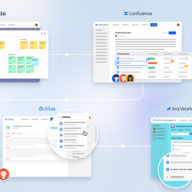4 important insights about the future of flexible work
It’s been about three years since the pandemic changed the future of work as we know it. And today, enterprises continue to embrace workplace flexibility.
The most recent Atlassian State of Teams report found that in 2022:
- 22% of teams worked remotely
- 35% worked in the office only
- 43% worked in a hybrid model
While the number of remote and in-office teams dropped from 2021, hybrid teams surged. So, it’s safe to say that the demand for workplace flexibility is here to stay.
Here, Senior Design Manager Sarah Karp and I reflect on four key (and surprising) workplace flexibility findings from the past year and how they impact our work at Atlassian. We hope some of our insights might be helpful to other teams.
1. Teams with location flexibility have a better organizational outlook
It’s not surprising at all that employees feel better about their company when they’re allowed the flexibility to work from where they want. After all, there’s lots to love about remote work—so much so that it’s almost become a requirement for people in their job search.
Teams can work from locations with more affordable costs of living. There’s little to no commuting involved. And team members can spend more time with their loved ones.
The State of Teams report showed that 83% of teams that reported having some flexibility had a positive org outlook. Meanwhile, only 47% of in-office teams reported the same.
But workplace flexibility doesn’t necessarily equal a remote workplace. For a flexible work model to be successful, it needs to also include the flexibility to meet face-to-face.
For many teams, the office setting offers opportunities to build connections and have some in-person interactions with their peers. While some of that can be replicated virtually, it’s not really the same as actual face-to-face time.
Tip: Offer hybrid workspaces
A hybrid workspace gives teams the choice of where they will do their best work each day. They have the flexibility to work remotely when they need to and work from an office or shared space for in-person interaction.
Make sure you have practices and tools in place that keep your dispersed teams connected, empowered, and engaged.
A work management solution like Atlassian Together, for example, can help you accomplish that by centralizing where team collaboration happens on products that are as flexible as your work schedule.
2. Teams with flexible workspaces consider themselves to be innovative
A surprising insight was that dispersed teams found more room to be innovative than in-office teams.
The State of Teams report stated that 71% of teams with some flexibility considered themselves to be innovative, while 57% of teams with no flexibility said the same.
Yes, the idea of location flexibility itself can be progressive and innovative. But delivering consistent innovation proves challenging with team members scattered across time zones.
After all, in-person whiteboard sessions with coworkers and unplanned hallway conversations are tough to replace.
Tip: Use processes and tools that support innovation in flexible workspaces
Innovation requires the right tools and processes.
Sarah recommends testing out different ways to foster a culture where teams are eager to develop new ideas for company initiatives and projects—just as we’ve done at Atlassian.
“This is where experimenting with innovation practices in smaller team environments can work wonders,” Sarah says. “I’ve found that running working agreements in a small group helps identify a team’s process needs (and solutions)—while running the Work Life impact workshop helps identify a team’s culture needs (and solutions).”
At Atlassian, we’ve run these working agreements and Work Life impact workshops using a virtual whiteboard tool. But from there, the results were brought over to team Trello boards.
“My favorite output has been stickers that represent the design team values, which we can place on cards that celebrate our team’s ‘values in action’ each month,” Sarah says. “Our team has more than doubled in size over the past year, and yet these types of remote-friendly practices have brought us much closer together.”
3. Teams believe flexible work increases transparency
“I was pleasantly surprised to see the increase in respect for different views and perspectives and the increased transparency in decision-making,” Sarah says.
About 63% of respondents in the State of Teams report said they had visibility into decisions made for their org—even as the flexible work landscape becomes permanent.
But with transparency comes a level of responsibility for making sure everyone’s voices are heard.
“It’s all too easy for us to fall back into ways of working that only celebrate the loudest voices in the room,” Sarah adds.
Tip: Offer further opportunities to give team members a voice in decision-making
Create diversity in your decision-making by taking proactive measures to make sure all voices are heard equally across your org.
What could that look like? Surveys, office hours, and even a company-wide vote.
“One thing that has worked much better in the hybrid work environment at Atlassian has been using anonymous polling and Q&A tools during company-wide or larger ‘all-hands’ meetings,” Sarah says. “This has allowed space for both people who are comfortable speaking up in those settings and, more importantly, people who previously struggled to have their voices heard.”
4. Teams with greater workplace flexibility spend more time in meetings
This one is, obviously, the negative. If your team is remote, odds are you’re meeting more often than you would in an office. The State of Teams report revealed that hybrid and remote teams spend three more hours per week in meetings than in-office teams do. And the report also discovered that more time spent in meetings was linked to an increased likelihood of burnout.
And that’s something that we, at Atlassian, experienced, too.
“The connection between burnout and meetings felt quite expected,” Sarah says. “I’m grateful that we already had so many remote-friendly and hybrid-friendly work practices in place. We still weren’t exempt from the meeting overload that happened as we grew our team and went through the first years of the pandemic, though.”
If this sounds a bit familiar, it’s time to look for opportunities for change.
Tip: Run regular ritual resets
Once we realized that meeting overload was a problem, we took that opportunity to conduct ritual resets. This is the formal process of examining team meetings and processes as a group and voting on which ones to keep, improve, or remove. It’s about asking yourself: How do we make room for the work that matters?
But this process has to be intentional.
“I don’t think that ritual updates need to happen across an entire organization,” Sarah says. “Different teams require different ways of working.”
Sarah suggests baby steps for rolling out ritual resets. Start with a select group of teams at your org and test out how meeting changes impact burnout.
“On my team, we’ve experimented with canceling our start-of-week goal-setting meeting on Zoom and replacing it with an async standup in Slack,” Sarah says. “We use our weekly design review meeting for structured face time and ad hoc design pairing sessions for less structured teamwork.”
If your test is successful, then you can implement these ritual updates more widely across the company.
Unify teams—no matter where they work—with Atlassian Together
As workplace flexibility becomes a permanent fixture, a new category of software is needed to support culture building, spontaneity, and team health.
Enter work management tools. Whether it’s project management, digital team collaboration, knowledge-sharing, or aligning on goals, work management solutions create a seamless process for teams. Even better if you get them all in one convenient package—like Atlassian Together.
The Atlassian Together solution includes:
Confluence: Connecting people and breaking down information silos is especially important in a remote and distributed environment. With Confluence, you can optimize everything in one place and create a single source of truth.
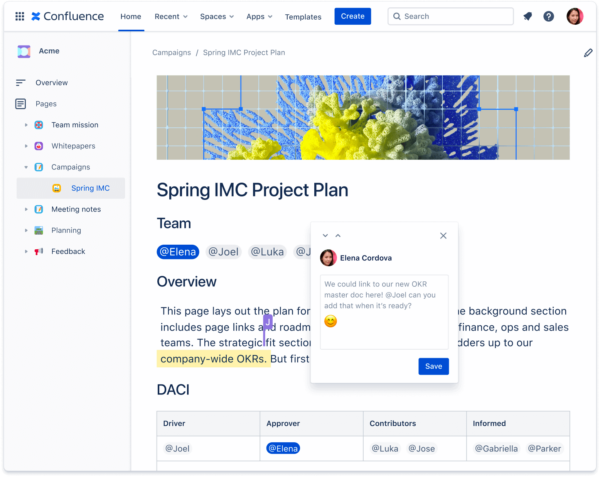
Jira Work Management: With Jira’s customization abilities, you can adapt the tool to your unique needs. View and manage your team schedules, allocate work, and easily track the status of tasks. Plus, you can create new projects quickly by choosing pre-built templates that fit your team’s needs. Collaborate, align, and deliver all in one place.
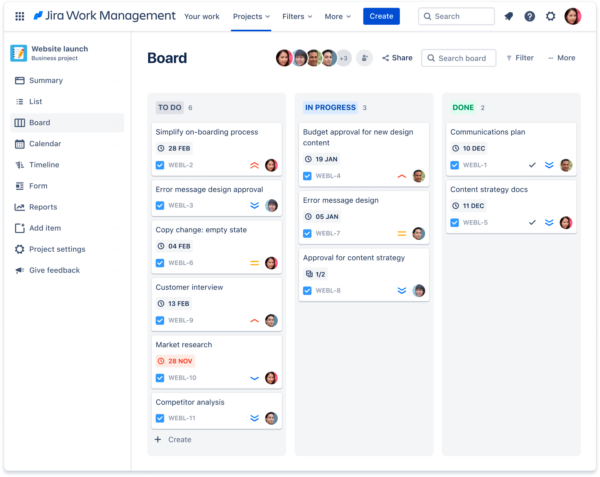
Atlas: With Atlas, you have a comprehensive team directory that makes it easy to stay aligned and get updates on projects that are relevant to you. And, Atlas can automatically aggregate teams, projects, goals, and knowledge by topic.
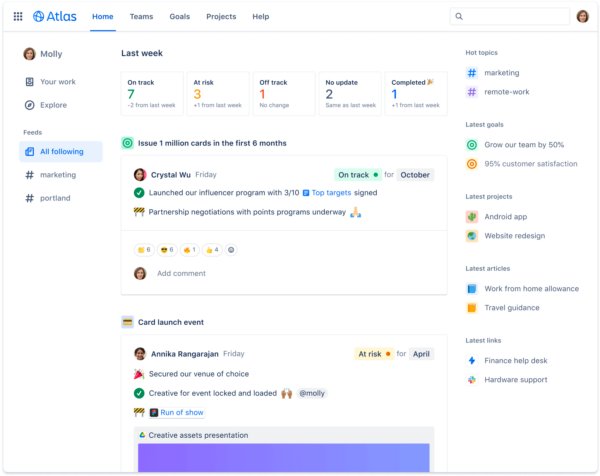
Trello: As workspaces continue to evolve, success rests on team alignment and cohesion. Trello views allow for better team alignment and work visibility. Trello Enterprise is tailor-made for flexible workspaces. (Just look at all the ways teams can use the tool.)
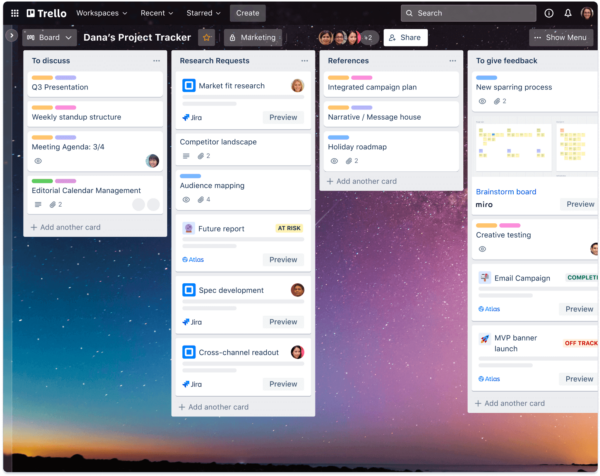
“As enterprises embrace a more flexible workplace, I think the products in the Atlassian Together solution will become even more important. They can be used in multiple ways to turn meetings we once thought were impossible to run remotely into thriving hybrid-friendly practices, to onboard employees and easily connect them to company resources, and as a way to encourage innovation through fun brainstorming sessions,” Sarah says.
Liam Greig is the Head of Design for Confluence.
Ready to power up your flexible workforce?


